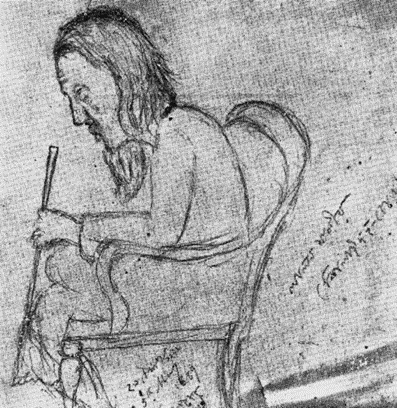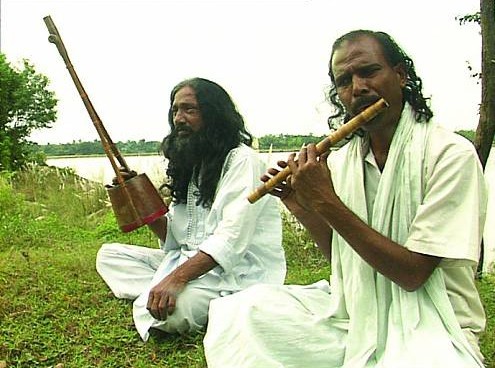Lalon Fakir is mainly represented through artistic interpretations rather than photographic records, as there are no verified photographs of him. A painting by Jyotirindranath Tagore from 1889 serves as the most significant visual representation of Lalon. It is regarded as the only portrait of Lalon created while he was alive. This piece of art, drawn on a boat on the Padma River, acts as a historical reference for his likeness.

Figure 1.1: Portrait by Jyotirindranath Tagore (1884)
Aside from this portrait, Lalon’s likeness has been represented in various artistic mediums, such as paintings, photographs of his shrine, and representations of his adherents. The goal of these depictions is to capture his spiritual essence and the Baul tradition he promoted. Although these visuals do not serve as direct representations, they embody the influence of Lalon’s teachings on culture and philosophy. These artistic representations are the main way Lalon’s image is kept and disseminated, given the lack of modern visual documentation.

Figure 1.2: Most common painting (Painted by Mir Zahid 1997)

Figure 1.3: (Lalon Picture – Yahoo Image Search Results)
To reflect his spiritual philosophy and rejection of materialism, Lalon Fakir is often depicted wearing simple, modest clothing. The garments he selects—like dhoti, kurta, or lungi in earthy tones—represent modesty and a profound bond with nature. Often in hues of brown, beige, and white, these garments reflect his conviction in the Dehatattwa or “Truth in the Body,” which underscores the idea of the human body as a divine temple. His depiction lacks elaborate embellishments, which emphasizes his point that spiritual enlightenment goes beyond external appearances and societal conventions.
Lalon’s teachings are made more accessible and relatable to the common people through this visual representation. Artists and followers emphasize his message that the divine resides within oneself, not in material wealth or external symbols, by depicting him in simple clothing. His portrayal as a roving mystic with few belongings mirrors the Baul tradition’s focus on inner truth and spiritual freedom rather than worldly status.
Male Attire

Figure 1.4: Male Baul Singers (Yahoo Image Search Results)
The male performers of Baul and Lalon usually don simple, practical garments that reflect their ascetic beliefs. A traditional cloth wrapped around the waist, the lungi is a common garment worn by male performers. This clothing item is well-suited to Bengal’s humid climate, providing freedom of movement during performances and spiritual activities. The dhoti, another traditional piece of clothing, is worn by many as a symbol of their connection to rural Bengali traditions. To increase comfort on long journeys and during extended performances, people wear the kurta or chola, a loose-fitting shirt that is frequently crafted from cotton. The Baul’s and Lalon’s bond with nature and their disdain for material wealth are mirrored in these garments, which are often in earthy hues like beige, brown, and ochre.
Male performers often use the ektara, a one-stringed instrument, and they commonly decorate themselves with simple necklaces or bangles to signify their spiritual journey. The headscarf or tassels wrapped around the head represent discipline and devotion, strengthening the ascetic lifestyle that lies at the heart of their beliefs. Their clothing is a conscious decision to highlight humility and simplicity, mirroring the philosophy of living without excess or adornment.
Female Attire

Figure 4: Female Baul (Yahoo Image Search Results)
While the simplicity of Baul performers’ attire is a common thread between the genders, female performers’ costumes tend to emphasize traditional femininity. The main garment is the saree, which is worn traditionally by women from Bengal. Nonetheless, these sarees are typically crafted from basic cotton material, selected for comfort and ease of movement. Worn modestly, the saree is complemented by a typically plain blouse (choli), which contributes to the unembellished, minimalist aesthetic central to Baul spirituality. Some female Bauls wear lungis or paris, which are simple cloths tied around the waist, enhancing their practical and comfortable attire.
As for adornments, women usually sport nose rings (nath) and bangles crafted from basic materials such as wood, clay, or low-cost metals. These decorations symbolize cultural identity and modesty. In some cases, women may adorn their hair with flowers, a symbol of beauty and dedication to the divine. The clothing and adornments of female Bauls, like those of their male counterparts, are designed not to exhibit wealth but to signify their profound spiritual commitment and bond with nature.
Symbolism and Importance of Their Clothing
The clothing worn by Baul and Lalon performers represents more than merely cultural or traditional choices; it serves as a depiction of their philosophical convictions. Their use of natural materials and earthy tones in clothing represents their profound bond with the earth and their disconnection from material wealth. The lightweight and comfortable cotton fabric, which is commonly worn, is ideal for the hot climate and symbolises their grounded nature. It is in accordance with their conviction of a simple lifestyle and a harmonious existence with nature, turning down the opulence of urban life and its distractions.
For practitioners of Baul and Lalon, their clothing is not a matter of vanity or status; rather, it reflects their ascetic lifestyle that values spiritual development more than physical appearance. Their philosophy centers on simplicity, and their clothing directly expresses this belief. Their choice of clothing—comfortable, practical, and modest—reflects their commitment to a life centered on spiritual fulfillment instead of material wealth.
Within the broader framework of Bengali folk traditions, the garments donned by Lalon and Baul performers symbolize their distinct lifestyle, profound spiritual ties, and rejection of the conventions of a materialistic society.
Author
Rezuana Tabassum

